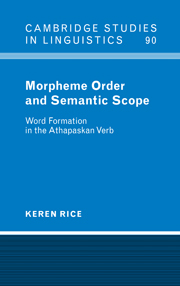Book contents
- Frontmatter
- Contents
- Preface
- 1 Introduction: Beginning the Journey
- PART I FIRST STEPS
- PART II THE LEXICAL ITEMS
- PART III THE FUNCTIONAL ITEMS
- 9 An Introduction to the Functional Elements
- 10 Pronominals
- 11 The Aspect System
- 12 Qualifiers and Their Ordering
- 13 On the Ordering of Functional Items
- PART IV A VIEW OF THE LEXICON
- PART V THE END OF THE JOURNEY
- PART VI APPENDIXES
- Notes
- References
- Name Index
- Languages Index
- Subject Index
9 - An Introduction to the Functional Elements
Published online by Cambridge University Press: 06 July 2010
- Frontmatter
- Contents
- Preface
- 1 Introduction: Beginning the Journey
- PART I FIRST STEPS
- PART II THE LEXICAL ITEMS
- PART III THE FUNCTIONAL ITEMS
- 9 An Introduction to the Functional Elements
- 10 Pronominals
- 11 The Aspect System
- 12 Qualifiers and Their Ordering
- 13 On the Ordering of Functional Items
- PART IV A VIEW OF THE LEXICON
- PART V THE END OF THE JOURNEY
- PART VI APPENDIXES
- Notes
- References
- Name Index
- Languages Index
- Subject Index
Summary
In this part of the book, I examine the functional items and their ordering. Whether the ordering of functional items follows from scope has been a point of controversy; see, for example, Anderson 1992, Baker 1992, Halle and Marantz 1994, Lapointe 1996, and Speas 1991a,b for discussion. Baker 1992 discusses this issue, asking: “The question is whether this kind of syntactic motivation can be extended to inflectional morphology … the plausibility of this approach depends on the degree to which the order of inflectional morphemes seems syntactically well-motivated” (102–103). Baker suggests that there are two reasons to pursue a hypothesis according to which the ordering of inflectional elements is principled. First are empirical considerations based on Bybee's research (1985a, 1985b). Bybee, in a crosslinguistic study of inflectional affix ordering, finds universal tendencies that she explains in terms of iconicity, or relevance to the verb. Speas 1991, in a small survey, finds similar results, as do Foley and van Valin 1984. This is one reason to believe that there are principles underlying the ordering of functional items. The second consideration that Baker brings to bear is methodological. A theory in which the ordering of inflectional elements reflects syntactic embedding allows for a restricted interface between syntax and inflection, whereas a theory in which the order of inflectional elements is idiosyncratic and language-particular makes no predictions.
- Type
- Chapter
- Information
- Morpheme Order and Semantic ScopeWord Formation in the Athapaskan Verb, pp. 175 - 179Publisher: Cambridge University PressPrint publication year: 2000



